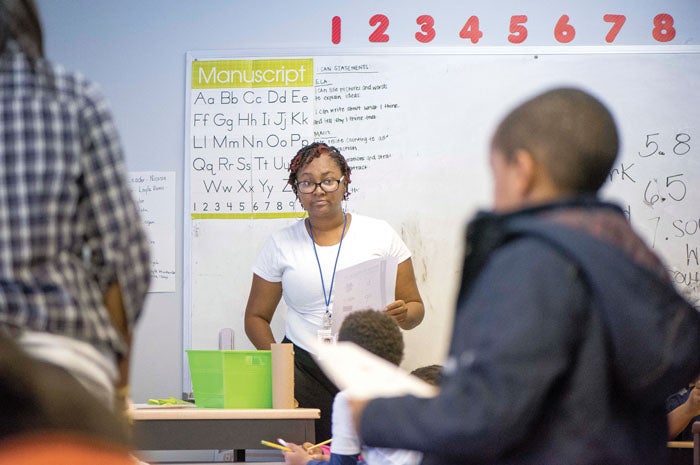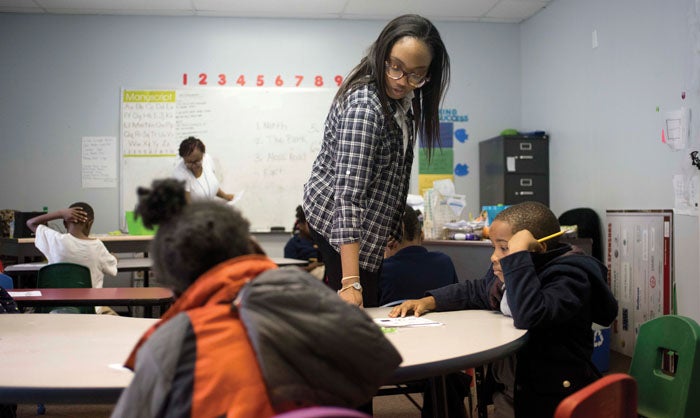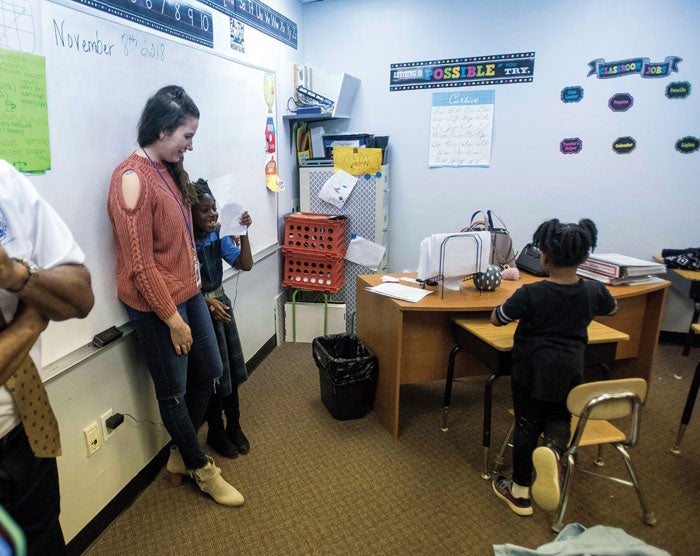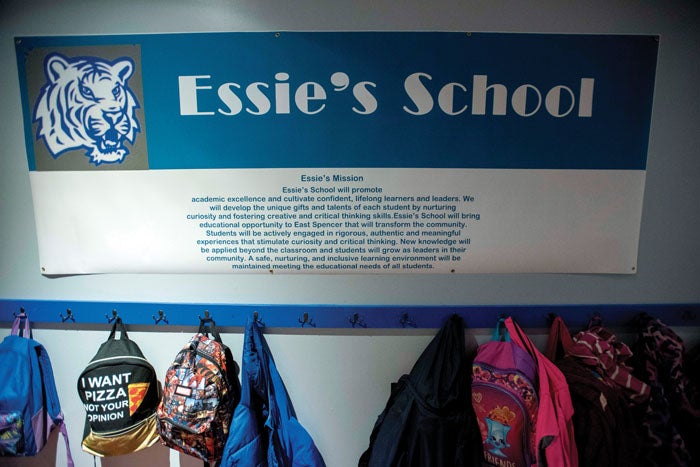Essie Mae Kiser Foxx Charter School: Love, care and respect
Published 12:02 am Thursday, November 15, 2018
By Maggie Blackwell
For the Salisbury Post
EAST SPENCER — First-grade boys file out of a silent classroom to go to the restroom. As they pass strangers, each one quietly says, “Excuse me, thank you.”
No, it’s not a dream. It’s the Essie Mae Kiser Foxx Charter School in East Spencer.
“’Love, care and respect’ — that’s my mantra,” says Principal Jonathan Pullin, “We’ve seen a marked difference in student behavior, absolutely. At the beginning of the school year, some kids wouldn’t listen to teachers; some had active behaviors. Our methodology of love, care and respect began to make a difference. Instead of hollering and punishing, we would give a hug and talk calmly. We came to a solution if there was an issue. Instead of talking negatively to them, we focus on the positive side.
“For example, a young lady was just in the office this morning for talking. We talked to her about Oprah Winfrey and told her she may have a great future talking. She understood that, came back and apologized to the teacher and will try to talk at appropriate times.
“There was a young man who, when he came to us, he just had difficulty following direction. He was in my office on my couch two, three times a day. He was angry, crying, just unhappy.
“I never see him in here anymore. I see him in the hallway. ‘What’s up, dude?’ and give him a hug.”
The school has 90 students in kindergarten through fourth grade. It plans to add a grade per year. Pullin anticipates 25 new students next year with the addition of fifth grade.
The school is on North Long Street in East Spencer in the Northside Community Center, owned by Northside Church of God of Prophecy. At 9,000 square feet, it’s a tight fit with just the five grades. Next year, Pullin anticipates the school may need to add an outdoor pod.
“More students were signed up, but didn’t come,” Pullin says. “Perhaps the parents wanted to see if we will succeed. … We are not an alternative school; we are an educational choice for parents. We do understand we are trailblazers, the only charter school in Rowan County. We are unique because we are serving a unique population. Our mission is to be sure we serve.”
The town hasn’t had a local community school since Paul Laurence Dunbar School closed in 1995 when North Rowan Middle School opened in nearby Spencer. Many feel that when a community doesn’t have a school of its own, it fails to prosper. This was the impetus behind creating Foxx Charter School.
Essie Mae Kiser Foxx was an East Spencer community advocate and mother of 13. She died in 2016.
Pullin proudly wears his school dress shirts every day and says local residents see him at the gas station or stores and remark, “Yes, I knew Miss Essie.”
Oddly, the mascot is a tiger, not a fox. Pullin says the mascot of the Dunbar school was a tiger. The charter school retained the tiger as mascot to keep the spirit of Dunbar — and the community — alive.
“This school will always be in East Spencer,” he said.
The school runs on a unified schedule. All classes study English, language arts, and reading for the first 90 minutes of the day. The next hour is devoted to math. This makes it easier, Pullin says, to monitor classes and ensure everyone is on the same page.
Pullin agrees that the sequence implies his priorities.
“If you can’t read, you can’t do math.”
Other classes include a half hour of Spanish, a half hour of art, a half hour of physical exercise and a half hour of cursive writing.
“I like to look at us as a laboratory school,” he says. “If something’s not working for us, we can change it on a dime.”
If it’s a major change, the school gets he permission of the state Department of Public Instruction.
Students playing basketball outside responded well to questions in Spanish. “Como te llama?” and “Como estas?” provoked immediate answers.
Students were assessed at the first of the year to identify a starting point.
“We needed to know what our students needed,” Pullin said. “Now when we are in a classroom, the instruction is differentiated. The assistants help greatly with differentiation.
“I know there can be a stigma among the other kids when a student is pulled out. We did not want to do that. We do not have in-school suspension. Along with our counseling services, we have another organization that is providing services to our families and kids.
“We try to talk it through with the kids. They are young and impressionable. What they bring to school is a reflection of the home. …
“The environment I’m working to develop is one of love, care and respect. Our teachers give that to the children, and we ask the children to give that back to us and to each other.
“The whole basis is critical thinking and problem solving. We want to teach them to do that from a very young age. It’s difficult to develop a new culture when it didn’t exist before, but so far, we are claiming success. We have our challenges every day, that’s for sure, but I see true progress.
“We teach the kids ‘yes ma’am’ and ‘yes sir.’ Some had been taught this at home. We have our school song that we’ve been working on.”
Partnerships
“We’ve had many strides lately. We won the community coalition from the NAACP on Saturday. This shows we are having an impact.
“Catawba College invited us to a football game Saturday before last. Parents, teachers, students, we marched to the stadium — we saw the football players. The kids had never done that. They were so impressed with the stadium. Our board chair (Tina Foxx Wallace, Essie’s youngest child) bought pom-poms for all the girls. They sat right behind the cheerleaders and shook their pom-poms. On the bus, they all proclaimed they want to go to Catawba.”
Five interns from Livingstone College help in the classrooms where they are needed. Pullin says it’s a mutually beneficial relationship as the interns get the credit they need and the school gets additional support.
The school received a grant from the Blanche and Julian Robertson Family Foundation, Pullin says, and he is currently applying to Salisbury Community Foundation.
With two kindergarten classes, two first grades, and one each second, third and fourth grades, the school is already outgrowing its building. Rooms are also used for counseling, food prep by caterers, a sick room and administration.
“We are negotiating with the church for more room,” Pullin says. “We’re adding more staff, equipment and students. In the third year, we are supposed to move into a larger, more permanent building. My vision is to grow the next two years. We are projecting 125 students next year and may have to add a pod.”
As he walks through the building, Pullin stops and picks up trash from the floor.
In the classroom
In one first-grade classroom, students stood around a round table. In the center were paper fish they had colored. Each fish bore a paper clip on its nose. Two students hold dowels with string and a magnet at the end.
“Who will catch the most fish?” asks their teacher, Kela Hunt. “Who’s going to eat good tonight? Now, why does the magnet work?”
The students give answers about positive and negative poles.
In another classroom, Morgan McRae is a first-year teacher.
“Having just 10 students allows me to be more hands-on,” McRae said. “They enjoy the personal attention. Having a full-time assistant helps me be more engaged with the students and meet their needs. I think the students respond best to our being calm and giving them plenty of attention.”
The average class size in the school is 15 students. In a second-grade room, the student who was reading at the front of the class could not read at the first of the year. Pullin was clearly ecstatic.
Another student had just been corrected on his behavior and was feeling a little sad. The teacher told him, “You worked it out, you apologized to the student, let’s just go forward.”
After a moment he did just that.
“Love, care and respect,” Pullin said. “It’s a tough job. We don’t run from it. What we have to do is create the perfect triangle with the student at the top, parents and teacher at the bottom. In the center is the community.
“It’s a tough job to get all those parts working together for the benefit of the kids. Sometimes we have to encourage one of the portions.
“Being in a leadership position is always tough. We are fundraising. To implement my vision is to improve the community of East Spencer through the children. Look 15 years down the road — when they graduate, go to college and work, they have the necessary skill sets. They have the reading and math. It’s a huge undertaking, but I’m committed.”








